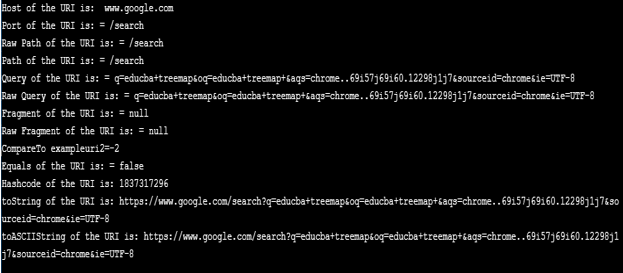Java.net URI
- PHPz원래의
- 2024-08-30 16:04:58462검색
Java.net 패키지는 해당 구성 요소에서 URI 인스턴스를 생성하거나 해당 구성 요소의 문자열 형식을 구문 분석하여 URI 인스턴스의 여러 구성 요소에 액세스하고 검색하는 메서드가 포함된 클래스 URI를 제공합니다.
광고 이 카테고리에서 인기 있는 강좌 JAVA MASTERY - 전문 분야 | 78 코스 시리즈 | 15가지 모의고사무료 소프트웨어 개발 과정 시작
웹 개발, 프로그래밍 언어, 소프트웨어 테스팅 등
URI란 무엇인가요?
Uniform Resource Identifier에는 특정 리소스 식별에 도움이 되는 일련의 문자가 있습니다. 또한 특정 프로토콜의 도움으로 네트워크를 통한 리소스 표현의 상호 작용을 돕습니다. 이 특정 수업에 대한 자세한 내용은 아래 섹션에서 논의됩니다.
구문
아래는 java.net URI 클래스의 구문입니다.
scheme:[//[user:password@]host[:port]][/]path[?query][#fragment]
- 구성표: 이 구성 요소는 URI와 연결된 특정 프로토콜을 배치합니다. 일부 구성표에서는 "//"가 필요하지만 다른 구성표에서는 사용되지 않습니다.
- authority: 이 구성 요소는 인증 부분, 호스트, 콜론 ':' 뒤에 오는 포트 번호 등 다양한 구성 요소로 구성됩니다. 첫 번째 섹션의 인증 섹션은 사용자 이름과 비밀번호로 구성됩니다. 동시에 두 번째 섹션 호스트는 IP 주소 중 하나일 수 있습니다. 세 번째 섹션 포트 번호는 선택 사항입니다.
- 경로: 특정 리소스에 대한 서버 내에 존재하는 주소로 구성된 문자열을 갖는 구성 요소입니다.
- query : 이 컴포넌트는 앞 부분의 '?' 물음표를 이용하여 특정 리소스를 찾는 쿼리를 사용한 비계층적 데이터입니다.
- fragment: 보조 리소스를 식별하는 구성 요소입니다. 페이지 등에 있는 제목이나 부제목일 수 있습니다.
Java.net URI 클래스는 어떻게 작동하나요?
이미 논의한 바와 같이 URI는 URL(Uniform Resource Locator)로 알려져 있으며 위치와 이름을 사용하여 이미지, 캐스케이드 스타일 시트 파일, 비디오 등과 같은 웹 리소스를 식별하는 데 도움이 됩니다. 여기서 위치는 특정 리소스에 액세스하거나 검색하는 메커니즘입니다. 예를 들어 HTTP://, FTP:// 등이 위치입니다. 또한 "이름"은 특정 리소스의 전역 특정 이름입니다. 다음 웹 주소 https://samplepath/path/to/video.mkv가 비디오를 검색하는 예를 살펴보겠습니다. 여기서 이 특정 주소의 샘플 경로/경로/to/video.mkv 섹션은 URN 또는 이름입니다.
건축자
다음은 URI의 5가지 생성자입니다.
- URI(String st): 문자열 st를 파싱하여 URI를 생성합니다.
- URI( String Scheme , String str, String frag): URI는 주어진 구성 요소로 구성됩니다.
- URI( String schm, String userinf, String Host, int portnum, String path, String query, String frag): 계층적 URI는 지정된 구성 요소로 구성됩니다.
- URI( String schm, String Host, String path, String frag): 지정된 구성 요소로 계층적 URI가 구성됩니다.
- URI( String schm, String suthorty, String path, String query, String frag): 지정된 구성 요소로부터 계층적 URI가 구성됩니다.
Java.net URI에 대한 메서드
다음은 여러 작업을 수행하는 URI 클래스의 다양한 메서드입니다.
- compareTo(URI ur): This URI will be compared with another URI.
- create(String str): A URI will be created on parsing the string str
- equals(Object obj): The URI will be tested for equality with the object obj
- getAuthority(): Returns the URI’s authority component, which is decoded.
- getFragment(): Returns the URI’s fragment component, which is decoded.
- getHost(): Returns the URI’s host component, which is decoded.
- getPath(): Returns the URI’s path component, which is decoded.
- getPort(): URI port number will be returned.
- getQuery(): Returns the URI’s query component, which is decoded.
- getRawAuthority(): Returns the URI’s raw authority component.
- getRawFragment(): Returns the URI’s raw fragment component.
- getRawPath(): Returns the URI’s raw path component.
- getRawQuery(): Returns the URI’s raw query component.
- getRawSchemeSpecificPart(): Returns the URI’s raw scheme-specific part.
- getRawUserInfo(): Returns the URI’s raw user information component.
- getScheme(): Returns the URI’s scheme component.
- getSchemeSpecificPart(): Returns the URI’s scheme-specific part which is decoded.
- getUserInfo(): Returns the URI’s user information component which is decoded.
- hashCode(): Returns URI hash code value.
- isAbsolute(): Checks whether the URI provided is absolute or not.
- isOpaque(): Checks whether the URI provided is opaque or not.
- normalize(): URI path gets normalized on calling this method.
- parseServerAuthority(): This method parses the authority component into user information, port, and host components.
- relativize(URI uri): Given URI gets relativized to the URI specified.
- resolve(String str): A new URI is constructed by parsing the string mentioned and resolving the same against the URI.
- resolve(URI uri): The given URI is resolved against the URI.
- toASCIIString(): Content of the URI mentioned is returned as a US-ASCII string.
- toString(): Content of the URI mentioned is returned as a string.
- toURL(): A URL gets constructed from the URI mentioned.
Examples to Implement Java.net URI
Now, let us see a sample program of java.net uri class.
Java program to demonstrate several methods in the class java.net.uri. //Java Program to demonstrate methods of URI class
Code:
import java.net.*;
class URIexample
{
public static void main(String[] args) throws Exception
{
String str = "https://www.google.com/search?q=educba+treemap&oq=educba+treemap+&aqs=chrome..69i57j69i60.12298j1j7&sourceid=chrome&ie=UTF-8";
// Creation of new URI by parsing the string
URI exampleuri = new URI(str);
//different methods of <u>uri</u> class
System.out.println("Host of the URI is: " + exampleuri.getHost());
System.out.println("Port of the URI is: = " + exampleuri.getPath());
System.out.println("Raw Path of the URI is: = " + exampleuri.getRawPath());
System.out.println("Path of the URI is: = " + exampleuri.getPath());
System.out.println("Query of the URI is: = " + exampleuri.getQuery());
System.out.println("Raw Query of the URI is: = " + exampleuri.getRawQuery());
System.out.println("Fragment of the URI is: = " + exampleuri.getFragment());
System.out.println("Raw Fragment of the URI is: = " + exampleuri.getRawFragment());
//another uri in order to demonstrate the method compareTo and equals
URI exampleuri2 = new URI(str + "fr");
System.out.println("CompareTo exampleuri2=" + exampleuri.compareTo(exampleuri2));
System.out.println("Equals of the URI is: = " + exampleuri.equals(exampleuri2));
System.out.println("Hashcode of the URI is: " + exampleuri.hashCode());
System.out.println("toString of the URI is: " + exampleuri.toString());
System.out.println("toASCIIString of the URI is: " + exampleuri.toASCIIString());
}
}
Output: In this program, different methods of java.net.uri class are used and displayed results based on that.

위 내용은 Java.net URI의 상세 내용입니다. 자세한 내용은 PHP 중국어 웹사이트의 기타 관련 기사를 참조하세요!

